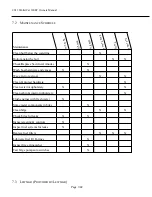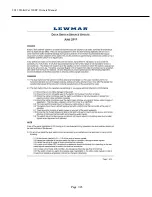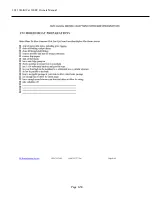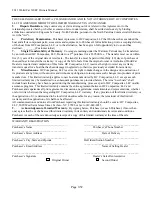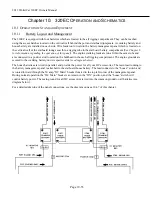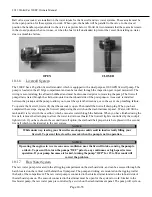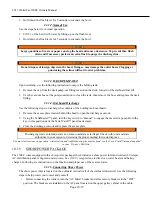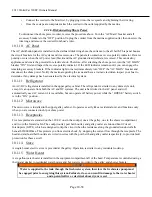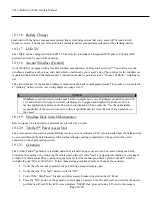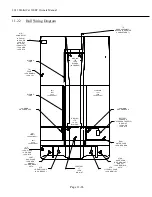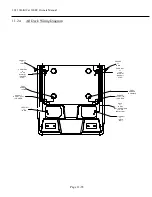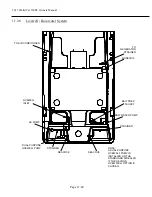
2013 World Cat 320EC Owners Manual
10.1.2 Bilge Pumps / Float Switches
Your 320EC is equipped with two 1500 GPH bilge pumps and two 500 GPH bilge pumps. Each pump is connected to
a float switch which automatically triggers the pump when water comes to rest in the bilge. The float switches are
connected to the battery management panel and receive power from the breaker along the top of the panel. These
breakers are constantly energized and ensure the safety of your boat even when the battery switches are in the “off”
position. The pumps can be manually engaged using the switches located on the dash.
The aft bilge pumps are located behind the aft rigging compartment and can accessed through the inspection plates in
the motorwell, forward of the engines. The wiring for these pumps is secured on the outboard side of the centerline
stringer which is visible from the inspection port. The forward pumps are located beneath the cabin liner. They can be
reached through the inspection ports installed in the cabin floor on either side of the master berth.
Inspect the operation of your bilge pumps and their connections at least annually. To do so, activate the pump by
momentarily lifting the arm on the float switch, then check the operation using the switches at the helm. When
testing, do not allow the pumps to run dry for more than two to three seconds. Extended dry operation can result in
damage to your pump. Keeping your bilge areas clean can also help extend the life of your pump.
10.1.3 Shower Sump
To collect discharge water from the galley sink, head sink, and shower drain, a sump is installed in the starboard
sponson. The sump is equipped with a bilge pump to evacuate grey water overboard and can be accessed using the
hatch in the floor of the head compartment. To gain access remove the screws from the sump cover in front of the
head. Check the sump at least twice per year to prevent the buildup of waste which could led to clogs, more often if
the sinks and shower are heavily used.
10.1.4 Freshwater System
The freshwater pump and wiring are located under the port lounge seat and can be accessed by removing the tackle
unit on the aft vertical wall of the seatbox. The freshwater pump is connected to the freshwater tank also located in
this area. The tank is filled through a fitting located on the portdecktop.
To pressurize the freshwater system, use the switch located on the dash instrument panel. Similar to residential well
pumps, the freshwater pump will pressurize the system to 45 psi. then shut down until the pressure drops below that
level. Most owners leave the pump “on” throughout the day, and use the system when necessary. On the 320EC, the
freshwater pump feeds the port freshwater fittings, water heater, galley faucet, head faucet, and marine head. To view
the layout of the freshwater system see the drawing on page 14.
NOTICE
During the initial fill of the water tank, or any refills after the system was completely purged, run
the freshwater pump to fill the plumbing lines and water heater for extra capacity.
10.1.5 SEACOCKS
Page 10-54
Summary of Contents for 2013 320EC
Page 1: ...2013 OWNER S MANUAL ...
Page 12: ...2013 World Cat 320EC Owners Manual Page 3 11 ...
Page 13: ...2013 World Cat 320EC Owners Manual 3 2 STANDARD EQUIPMENT ON ALL WORLD CATS Page 3 12 ...
Page 14: ...2013 World Cat 320EC Owners Manual 3 3 320EC OPTIONS LIST Page 3 13 ...
Page 35: ...2013 World Cat 320EC Owners Manual 6 10 TRADITIONAL ROCKER SWITCH DIAGRAM Page 6 34 ...
Page 44: ...2013 World Cat 320EC Owners Manual Page 7 43 ...
Page 45: ...2013 World Cat 320EC Owners Manual Page 7 44 ...
Page 46: ...2013 World Cat 320EC Owners Manual Page 7 45 ...
Page 47: ...2013 World Cat 320EC Owners Manual Page 7 46 ...
Page 49: ...2013 World Cat 320EC Owners Manual Chapter 8 HURRICANE PREPAREDNESS Page 8 48 ...
Page 50: ...2013 World Cat 320EC Owners Manual Page 8 49 ...
Page 51: ...2013 World Cat 320EC Owners Manual Page 8 50 ...
Page 72: ...2013 World Cat 320EC Owners Manual 11 2 10 Thru hull Diagram Page 11 71 ...



